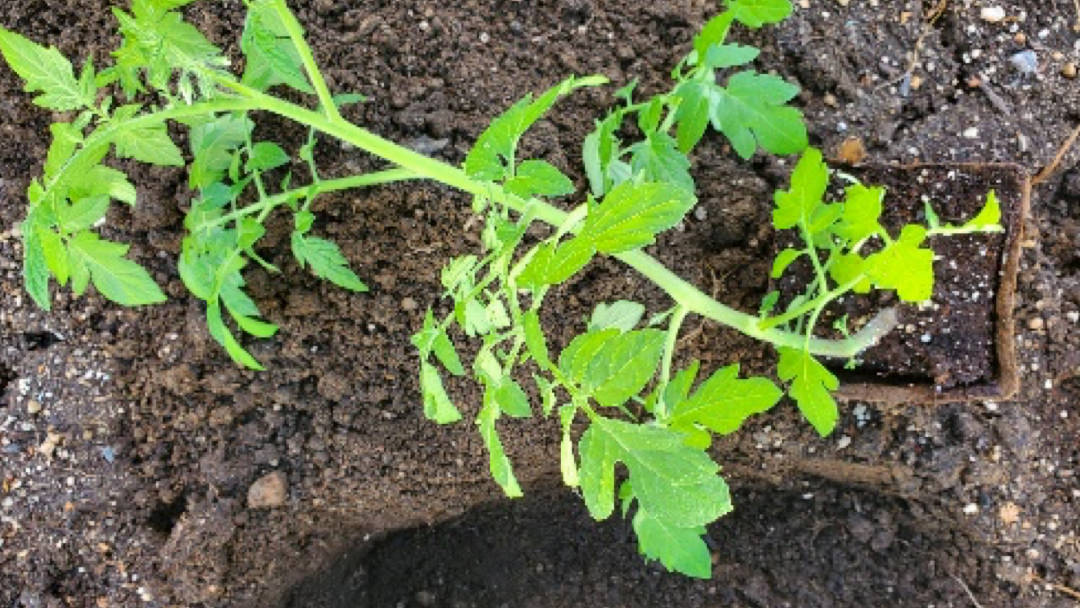
Tomatoes – Seed to Sauce Part 7 – Hardening Off & Planting – It’s a Process
The last frost has past, the days are longer and sunny, the soil is warm, and it’s time to move your tomato plants out into the garden. With all the care, preparation and ‘training’ your plants have received, they’re still not ready. Mother Nature can be very hard on them. Wind, changing humidity, direct sun, cold rain, and cool night time temperatures all can add to the shock of moving outside which can damage or stunt your plants. The last stage to prepare your seedings before you transplant them into the garden is called Hardening-Off and takes about a week to 10 days. It’s a process; each step can be one day or a few days for each step, depending on how wimpy your plants still are and how fast they adjust past each stage.
- First few days – bring your young tomato plants outside and place them in full shade for the day, but bring them in each night.
- Next step (again, a few days) is a few hours in the early morning or very late afternoon sun, into the shade during the hottest part of the day and then inside at night.
- The next step is all day (aprox. 8 hours) in the sun. At night, cover them with an old bed sheet supported with patio chairs, or use a floating row cover such as ReMay. This can be a single day or multiple days.
- Last step – all day in the sun and overnight uncovered. Because of the exposure to direct sun, wind or lower humidity, these plants will need more water than they required during their final week inside. Plants can stay in this stage (or the previous one) for as long as necessary until the soil warms adequately. If there is any heavy frost or freeze warning – make sure to bring your plants inside.
It’s finally time to plant into the garden! When to plant is an educated guess every year. Wait until the soil temperature warm* and the normal danger of frost is past. The day before you plan to plant into the garden, hold off watering the plants in their pots. If possible, try to plan planting on an overcast day or even in the rain. If that’s not possible, then plant in the early evening.

Your plants are short and stocky; about 4”-6” tall with a sturdy main stem and dark green leaves! Or …. maybe not. Are your plants a little too tall? With large spaces between leaves on the stems? Compare the plants in the photo. Not to worry, Mother Nature will fix that with a little help from you. Those hairs on the stem when covered with soil will become new roots. Rather than planting deep (where the soil is colder), try trench planting (see diagram). ~as you can see below, my plants grew a little tall too.

Water the hole – Not the plant. This saying was shared with me by a farmer in North Guilford when I first started to garden. Dig the hole, fill it with water and allow the soil around the hole to absorb the water. Add soil amendments or fertilizer as needed and fill the hole again with water. If you use Cow Pots, just remove any leaves that will be covered with soil (up to, but not beyond the first set of flower buds). If your plants are in pots, gently remove them by squeezing the sides of the container and pulling them out by the leaves, not the stem if possible. Again, remove all leaves that will be under the soil. Planting in the mud is messy but gives the young plant less transplant shock and it will recover quickly.

Cover the stem with soil up to the leaves. Don’t worry if the plant appears to be lying on its side if you trench plant, and don’t try to bend it upright. Within a few days it will face the sun on its own. Most tomato plants can get BIG and they appreciate room to grow. Pruning (discussed in Part 9) can help control the size to some extent, but if you are growing a variety like Brandywine, they will not be contained to 3 feet high and still produce fruit. The rule of thumb is to give each tomato plant a minimum of 4 square feet. If you plant them too close, you will get less fruit produced and smaller fruit on each plant. Give them the room they need now, even if the garden looks sparce.

Although the plants are still small, now is the time to add the supports they will need later. Once established, young tomato plants grow FAST. If you wait too long, you’ll end up breaking branches and risking damage to the plants trying to wrangle a cage around a 2 foot plant! If you needed to trench plant, by adding the supports now, you’ll know where the roots of your plant are so you don’t cut them trying to add the support later. There are lots of options for how to support your tomato plants. Check out part 8 of Tomatoes – Seed to Sauce for some ideas.
*The minimum soil temperature for tomato transplants is 55° at 4” below the surface of the ground. If you’re planting deep, take the temperature at whatever depth you plan to plant.
